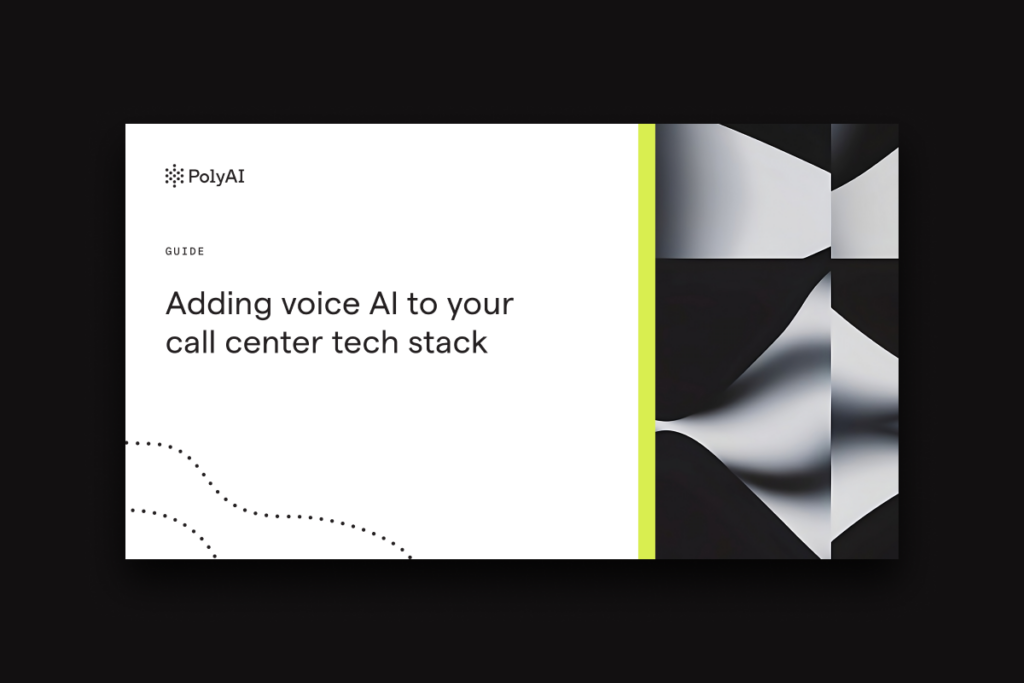Table of Contents
At HIMSS25 Global Health Conference and Exhibition, AI was a key focus, but in the healthcare industry’s highly regulated environment, the question remains: how can innovative technologies like AI be effectively implemented safely while building and retaining patient trust?
The PolyAI team spent time speaking with healthcare professionals, learning firsthand about their approach to patient experience and their thoughts on adopting new technologies.
Here’s what we found:
1. Develop a clear AI adoption strategy
Organizations need a clear strategy to adopt AI effectively. This involves developing policies to address regulatory, technical, financial, and domain-specific risks. A strong approach includes frameworks for responsible AI and systems engineering that cover both AI and cybersecurity.
As AI evolves, governance will be necessary to ensure safety and ethics. Balancing innovation with responsible oversight is crucial. Healthcare organizations face regulatory challenges but also have an opportunity to shape regulations that support both progress and security.
For CIOs in the US, it’s a balancing act between the pressure to innovate and managing risks. One solution is the growth of Self-Regulating Organizations (SROs), where industry associations set best practices that could eventually be formalized by Congress. The private sector is also creating assurance labs to build governance frameworks, though this process is complex and costly. Leading health systems are making progress by setting up committees dedicated to AI governance.
Transforming the patient experience with conversational AI.
Read now2. Foster workforce inclusion for AI success
AI can reduce administrative tasks and alleviate clinicians’ mental strain, but it can also introduce new challenges.
For successful AI implementation, healthcare organizations must set realistic expectations and build trust through transparency, education, and involving clinicians in AI development. They must also address concerns about job displacement and increased workload through continuous monitoring and clear communication about AI performance.
Further, healthcare organizations need to break down silos and work together, creating opportunities for collaboration between clinical, operational, and IT teams. The importance of value-based care and aligning financial incentives with AI adoption is key. Success can be achieved through early physician engagement, clear goal-setting, and learning from both successes and failures.
3. Ensure transparency to build trust in AI
AI has the potential to process vast amounts of healthcare data, but for it to truly add value in clinical decision-making, it needs to be both transparent and trustworthy. Without this transparency, healthcare providers won’t feel confident in using AI to guide their decisions.
Deep learning models are often seen as “black boxes,” making it difficult to understand how they arrive at their predictions, especially when dealing with complex data. To overcome this challenge, the explanations behind AI’s decisions must be clear and tailored to the knowledge healthcare providers already have.
Models must not only provide predictions but also explain how they arrived at those conclusions using terms and concepts that healthcare professionals are familiar with. This transparency helps build trust and allows clinicians to incorporate AI into their decision-making with confidence, knowing when the model might be wrong or unreliable.
Voice AI in health insurance
Explore real-world examples of how voice AI can handle tasks like claims processing, policy renewals, and multilingual support.
Read now4. Address infrastructure, skills, and support to overcome AI implementation barriers
Many healthcare organizations face significant barriers to implementing AI, such as inconsistent broadband access, outdated technology, and staff shortages. These challenges are especially evident in rural areas, where legacy systems and limited digital literacy among patients slow progress.
To overcome these obstacles, a focus on “AI readiness” is essential. This means improving infrastructure, developing staff skills, and ensuring that vendor support is tailored to each organization’s unique needs. Vendors are encouraged to provide ongoing assistance and support throughout the implementation process, helping ensure that AI tools are both effective and sustainable in these environments.
5. Prioritize data quality and patient engagement
While healthcare organizations are skilled at reporting data to government agencies, using this data for AI applications requires careful consideration of its quality and relevance. Some healthcare leaders are hesitant to adopt new AI tools, often waiting for EHR transitions—moving from one electronic health record system to another—which highlights the need for more immediate solutions.
Trust in new technology may be low in rural and underserved populations, making patient engagement a key concern. Pilot programs are being developed to assess how well patients accept AI tools, ensuring that privacy issues and user experience are carefully considered over time.
6. Lead your AI implementation; don’t let it lead you
AI initiatives often fail due to integration challenges, lack of leadership, and poor change management. However, failures should be seen as learning opportunities. Engaging with frontline staff and understanding their workflows is essential for success. Strong leadership and effective communication are needed to manage AI effectively. Governance, continuous improvement, and a flexible change management approach will also help organizations lead AI rather than let it lead them.
Unlocking the full potential of AI in healthcare
AI is already making a significant impact in healthcare, from improving disease screening accuracy to enabling proactive care and freeing up healthcare professionals from routine tasks, allowing them to focus on more complex cases and patient interaction.
Yet there is huge untapped potential for AI in healthcare, but its success depends on how it is integrated, governed, and managed. With the right strategy, clear communication, and strong leadership, healthcare organizations can overcome challenges and unlock the full potential of AI to improve patient care and operational efficiency. By taking a proactive approach, organizations can shape the future of healthcare with AI in a way that benefits both providers and patients.
Speak to our team today about how PolyAI can help you simplify patient access over the phone. Take appointments, answer FAQs, and route phone calls with a conversational AI agent.
Healthcare and voice AI FAQs
Healthcare providers must ensure that voice AI solutions comply with regulations such as HIPAA and GDPR. These frameworks mandate strong encryption, secure data storage, and strict access controls to safeguard sensitive patient information. Responsible AI providers also implement rigorous auditing and monitoring to prevent unauthorized access and ensure regulatory adherence.
Voice AI enhances patient experience by enabling more natural and empathetic interactions. It recognizes emotions, understands conversational nuances, and adapts to patient responses, making it easier for patients to communicate their needs and receive accurate support.
Voice AI can adjust its tone to be more empathetic during emotionally sensitive situations, such as when a patient is dealing with grief or a health crisis. By understanding context and emotional cues, voice AI can make patients feel heard and understood, even when interacting with an automated system.
Yes, by automating routine tasks like appointment scheduling, prescription requests, and handling FAQs, voice AI can significantly reduce the workload on human agents, allowing them to focus on more complex or sensitive issues, thus improving overall efficiency.




